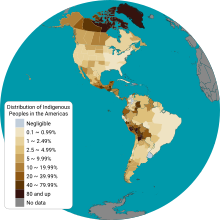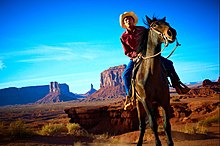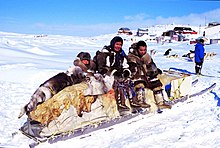Kelompok pribumi di Amerika: Perbedaan antara revisi
k namun (di tengah kalimat) → tetapi |
Rescuing 1 sources and tagging 0 as dead.) #IABot (v2.0.8 |
||
| Baris 77: | Baris 77: | ||
|region24 = {{flag|Trinidad dan Tobago}} |
|region24 = {{flag|Trinidad dan Tobago}} |
||
|pop24 = 1,460 |
|pop24 = 1,460 |
||
|ref24 = <ref>https://guardian.co.tt/sites/default/files/story/2011_DemographicReport.pdf | page 15</ref> |
|ref24 = <ref>https://guardian.co.tt/sites/default/files/story/2011_DemographicReport.pdf {{Webarchive|url=https://web.archive.org/web/20171019211618/https://guardian.co.tt/sites/default/files/story/2011_DemographicReport.pdf |date=2017-10-19 }} | page 15</ref> |
||
|languages = [[Rumpun bahasa Amerika asli]], [[Bahasa Inggris|Inggris]], [[Bahasa Spanyol|Spanyol]], [[Bahasa Portugis|Portugis]], [[Bahasa Prancis|Prancis]], [[Bahasa Denmark|Denmark]], [[Bahasa Belanda|Belanda]] |
|languages = [[Rumpun bahasa Amerika asli]], [[Bahasa Inggris|Inggris]], [[Bahasa Spanyol|Spanyol]], [[Bahasa Portugis|Portugis]], [[Bahasa Prancis|Prancis]], [[Bahasa Denmark|Denmark]], [[Bahasa Belanda|Belanda]] |
||
|religions = {{plainlist| |
|religions = {{plainlist| |
||
Revisi per 3 Maret 2021 08.26
 Persebaran penduduk asli Benua Amerika pada saat ini | |
| Jumlah populasi | |
|---|---|
| Sekitar 60.5 juta | |
| Daerah dengan populasi signifikan | |
| 25.7 juta[1] | |
| 6.8 juta[2] | |
| 6.0 juta[3] | |
| 5.8 juta[4] | |
| 3.4 juta | |
| 2.9–5 juta[5] | |
| 2.0 juta[6] | |
| 1.4 juta[7] | |
| 1.4 juta[8] | |
| 955,032[9] | |
| 817,963[10] | |
| 524,000[11] | |
| 520,000[12] | |
| 443,847[13] | |
| 204,000[14] | |
| 95,235[15] | |
| s. 70,000[16] | |
| s. 114,000[17] | |
| s. 60,000[18] | |
| s. 51,000[19] | |
| s. 24,501 (Maya)[20] | |
| s. 19,000[21] | |
| s. 12,000–24,000 | |
| 1,460[22] | |
| Bahasa | |
| Rumpun bahasa Amerika asli, Inggris, Spanyol, Portugis, Prancis, Denmark, Belanda | |
| Agama | |



Penduduk asli Benua Amerika adalah suku bangsa pra-Kolumbia di benua Amerika dan para keturunannya.
Indígenas atau pueblos indígenas (artinya "penduduk pribumi") adalah sebuah istilah umum di negara-negara pemakai bahasa Spanyol, dan pueblos nativos atau nativos (artinya "penduduk asli" dalam esensi keturunan non-imigran) merupakan sebutan umum di Chili, sementara aborigen (aborigin) digunakan di Argentina, dan pueblos aborígenes (penduduk aborigin) adalah kata umum di Chili. Istilah "Amerindian" (kependekan dari "'orang Indian di Amerika)" digunakan di Quebec, Guiana, dan Karibia pemakai bahasa Inggris.[23][24][25][26] Penduduk asli umumnya dikenal di Kanada sebagai orang aborigin, yang tak hanya meluputi Bangsa-Bangsa Pertama dan Inuit Arktik, tetapi juga populasi minoritas ras belasteran Bangsa Pertama-Eropa suku Métis[27]
Catatan
- ^ "Archived copy" (PDF). Diarsipkan dari versi asli (PDF) tanggal 4 March 2016. Diakses tanggal 2015-12-12.
- ^ "CIA - The World Factbook". Cia.gov. Diakses tanggal 23 February 2011.
- ^ "Composición Étnica del Perú". Diakses tanggal 14 January 2017.
- ^ http://www.ine.gob.gt/sistema/uploads/2014/02/26/L5pNHMXzxy5FFWmk9NHCrK9x7E5Qqvvy.pdf
- ^ United States Census Bureau. The American Indian and Alaska Native Population: 2010
- ^ http://estudios.anda.cl/recursos/censo_2012.pdf[perlu rujukan lengkap]
- ^ Canada 2011 Census [1]
- ^ DANE 2005 National Census
- ^ "Población indígena o descendiente de pueblos indígenas u originarios en viviendas particulares por sexo, según edad en años simples y grupos quinquenales de edad" (xls). INDEC (dalam bahasa Spanish). 2010. Diakses tanggal 2 May 2015.
- ^ "2010 Census graphics of Brazil government". IBGE(Brazilian Institute of Geograph and Statistic. 2015-02-09.
- ^ "About this Collection" (PDF). The Library of Congress. Diakses tanggal 29 July 2015.
- ^ "CIA - The World Factbook - Honduras". Cia.gov. Diakses tanggal 2013-12-03.
- ^ 2005 Census
- ^ "CIA - The World Factbook". Cia.gov. Diakses tanggal 23 February 2011.
- ^ "8 LIZCANO" (PDF). Diarsipkan dari versi asli (PDF) tanggal 20 September 2008. Diakses tanggal 2014-05-22.
- ^ "Una comunidad indígena salvadoreña pide su reconocimiento constitucional en el país". soitu.es. Diakses tanggal 23 February 2011.
- ^ "Costa Rica: Ethnic groups". Cia.gov. Diakses tanggal 21 December 2010.
- ^ Lector de Google Drive. Docs.google.com. Retrieved 12 July 2013.
- ^ The World Factbook. Cia.gov. Retrieved 12 July 2013.
- ^ Redatam::CELADE, ECLAC - United Nations[pranala nonaktif permanen]. Celade.cepal.org. Retrieved 12 July 2013.
- ^ [2] Diarsipkan 20 August 2011 di Wayback Machine.
- ^ https://guardian.co.tt/sites/default/files/story/2011_DemographicReport.pdf Diarsipkan 2017-10-19 di Wayback Machine. | page 15
- ^ "Terminology." Survival International. Retrieved 30 March 2012. "Aborigen" Diccionario de la Real Academia Española. Retrieved 8 February 2012.
- ^ Reid, Basil. "Tracing Our Amerindian Heritage". www2.sta.uwi.edu. Diakses tanggal 2016-02-10.
- ^ Guide, Barbados.org Travel. "The Abbreviated History Of Barbados". www.barbados.org. Diakses tanggal 2016-02-10.
- ^ Limited, Unique Media Design. "diGJamaica :: Amerindian Jamaica". diGJamaica.com. Diakses tanggal 2016-02-10.
- ^ "Terminology". Indian and Northern Affairs Canada. Diakses tanggal 11 November 2009.
The Canadian Constitution recognizes three groups of Aboriginal people — Indians (First Nations), Métis and Inuit. These separate peoples have unique heritages, languages, cultural practices, and spiritual beliefs
Sumber
- Gaskins, S. (1999). "Children's daily lives in a Mayan village: A case study of culturally constructed roles and activities". Children's engagement in the world: Sociocultural perspectives: 25–61.
- Nimmo, J. (2008). "Young children's access to real life: An examination of the growing boundaries between children in child care and adults in the community". Contemporary Issues in Early Childhood. 9 (1): 3–13. doi:10.2304/ciec.2008.9.1.3.
- Morelli, G.; Rogoff, B.; Angelillo, C. (2003). "Cultural variation in young children's access to work or involvement in specialised child-focused activities". International Journal of Behavioral Development. 27 (3): 264–274. doi:10.1080/01650250244000335.
- Woodhead, M. (1998). Children's perspectives on their working lives: A participatory study in Bangladesh, Ethiopia, the Philippines, Guatemala, El Salvador and Nicaragua.
- Rogoff, B.; Morelli, G. A.; Chavajay, P. (2010). "Children's Integration in Communities and Segregation From People of Differing Ages". Perspectives on Psychological Science. 5 (4): 431–440. doi:10.1177/1745691610375558.
- Gaskins, S. (2006). 13 The Cultural Organization of Yucatec Mayan Children's Social Interactions. Peer relationships in cultural context, 283.
Buku
- König, Eva (2002). Indianer 1858-1928, Photographische Reisen von Alaska bis Feuerland. Museum für Volkerkunde Hamburg: Edition Braus. ISBN 3-89904-021-X.
- Cappel, Constance (2007). The Smallpox Genocide of the Odawa Tribe at L'Arbre Croche, 1763: The History of a Native American People. Lewiston, N.Y.: Edwin Mellen Press. ISBN 978-0-7734-5220-6. OCLC 175217515.
- Cappel, Constance,(editor) (2006). Odawa Language and Legends: Andrew J. Blackbird and Raymond Kiogima. Xlibris. ISBN 1-59926-920-1.
- Churchill, Ward (1997). A Little Matter of Genocide: Holocaust and Denial in the Americas, 1492 to the Present. San Francisco: City Lights Books. ISBN 978-0-87286-323-1. OCLC 35029491.
- Dean, Bartholomew (2002). "State Power and Indigenous Peoples in Peruvian Amazonia: A Lost Decade, 1990–2000". Dalam Maybury-Lewis, David. The Politics of Ethnicity: Indigenous Peoples in Latin American States. David Rockefeller Center series on Latin American studies, Harvard University. 9. Cambridge, Mass.: Harvard University/David Rockefeller Center for Latin American Studies. hlm. 199–238. ISBN 0-674-00964-9. OCLC 427474742.
- Dean, Bartholomew; Levi, Jerome M. (2003). At the Risk of Being Heard: Identity, Indigenous Rights, and Postcolonial States. Ann Arbor: University of Michigan Press. ISBN 978-0-472-09736-4. OCLC 50841012.
- Dean, Bartholomew (January 2006). "Salt of the Mountain: Campa Asháninka History and Resistance in the Peruvian Jungle (review)". The Americas. 62 (3): 464–466. doi:10.1353/tam.2006.0013. ISSN 0003-1615.
- Kane, Katie (1999). "Nits Make Lice: Drogheda, Sand Creek, and the Poetics of Colonial Extermination". Cultural Critique. University of Minnesota Press. 42 (42): 81–103. doi:10.2307/1354592. ISSN 0882-4371. JSTOR 1354592.
- Krech, Shepard III (1999). The Ecological Indian: Myth and History. New York: W. W. Norton & Company. ISBN 978-0-393-04755-4. OCLC 318358852.
- Varese, Stefano; Ribeiro, Darcy (2004) [2002]. Salt of the Mountain: Campa Ashaninka History and Resistance in the Peruvian Jungle. trans. Susan Giersbach Rascón. Norman: University of Oklahoma Press. ISBN 0-8061-3512-3. OCLC 76909908.
Bacaan tambahan
- Hamilton, Charles (ed) (1950). Cry of the Thunderbird; the American Indian's own story. New York: Macmillan Company
Pranala luar
- "Information About California Tribes" Northern California Indian Development Council
- The Peopling of the American Continents, Early California History
- Indigenous Peoples in Brazil. Instituto Socioambiental (ISA)
- America's Stone Age explorers, PBS Nova
- A history of Native people of Canada - The Canadian Museum of Civilization
- Native Land An interactive website mapping First Nations territories, languages, and treaties in North America.
 Chamberlain, Alexander Francis (1911). "Indians, North American". Encyclopædia Britannica (edisi ke-11).
Chamberlain, Alexander Francis (1911). "Indians, North American". Encyclopædia Britannica (edisi ke-11).- Composición Étnica del Perú
